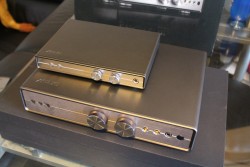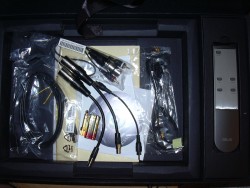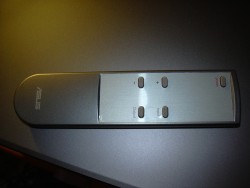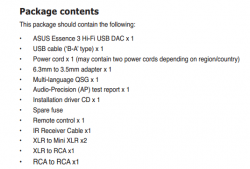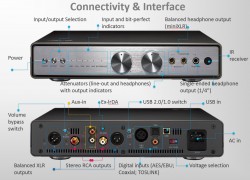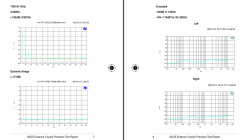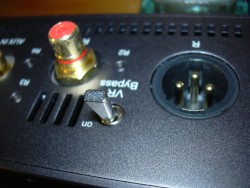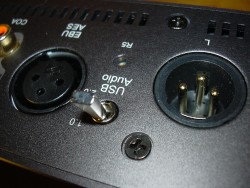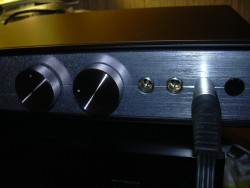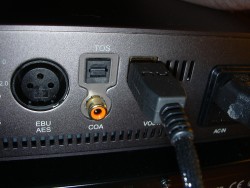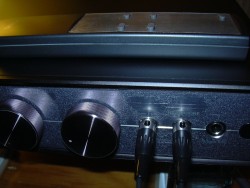Intro
So yeah, finally I was able to sit down, gather my thoughts and write what's below. Xonar Essence III is a very special product for me. Reason behind this statement is simple: it was able to replace one particular device I was very attached to over last two years or so. For now I won't write down what's the name of brick that had to go, but it had to and that's a fact. Xonar Essence III got me a bit closer to the sound I always liked to hear, cost no object wise. In the long run I'm aiming at AMR DP-777 or Aqua Audio La Scala. Yup, big toys, and they have some things in common, both in terms of sound and build. NOS multibit d/a converters and tubes? It has to be good if you ask me. I've heard stage four Lampizator more than two years ago, and got hooked up. Device internally built like that is my way out, for now I'm fooling myself that having one of those similarily designed bricks I'll be finally able to stop DAC searches and focus on some serious class A monos. Not that NuForce RE9 V3SE I use are bad or something.
Anyway, Xonar Essence III arrived, and as I wrote, it got me a bit closer to two things I'm really after these days; smoothnes and as much organic presentation as possible. Both are something plainly obvious when multibits and tubes are on the table. I'm into audio long enough to know that's my Holy Grail. Soundwise, smoothness, organic, natural and lifelike presentation is a big thing in my book. And when it comes down to Asus - also novelty. Those aspects of sound were beyond reach in products of that company (and many other as well) thus far. And yes, I've heard each and every DAC and soundcard Asus has in portfolio. I'm not saying that desktop solutions of that particular manufacturer aren't musical. Yet, certain level, or intensity if you will, of sound aspects I've mentioned above are reserved for far more expensive devices. And when I'm talking expensive, I mean Auralic Vega or PS Audio DirectStreamDAC. But that's another story, and another step in delivering me what I want to hear.My first contact with Essence III model was in December 2013. And it has been with me ever since. Polish Asus folks were kind enough to let me use it when the device wasn't needed. And since very little people are interested in and capable of reviewing that kind of equipment, it was with me almost constantly over last couple months. So I got lots of time to know it, and compare to other devices. Because I don't want to overwhelm you guys with too much of a lecture, I'll try to keep the crucial parts as short as possible.
Two, scratch that, three disclaimers before we go:
1. I hadn't payed for Xonar Essence III, it was delivered to me as a free sample, no journalistic surprises or secrets here. It came directly from Asus HQ.
2. I'm not affiliated with companies mentioned in this article in neither financial, nor personal way. Though, obviously, I know PR people working there, but we get along only on professional level and that's it. To be honest, lady from polish Asus crew helped me to get things done.
3. Sorry about my language skills, I'm aware that they could use some improvement. But I honestly believe that by writing stuff such as this review I'll get better. If you consider yourself as a language purist and are afraid your eyes might fall off, please stop reading here.
List of music I used is quite vast: Nine Inch Nails, Bat For Lashes, Rebecca Pidgeon, Einsturzende Neubauten, Corvus Corax, The Knife, Fever Ray, early albums of Mike Oldfield, Filter, Wardruna, Pig, Ministry, Michael Goddard/Monteverdi, Dead Can Dance, KMFDM, Jarboe, Muse, David Lynch, Therion and some Chesky's stuff to name a few. No additional details are needed here, but if someone asks about specific tracks, I'll gladly answer.
Thoughts about build quality
I won't wirte about materials used in Xonar Essence III, as this is commonly known thing. What I can do is to tell you guys what I think about it overall. To make it short, to me Xonar Essence III isn't quite "there" yet. The reasoning is simple: many devices similarily priced to Asus flagship are a tad better on this particular field. More on that below. I'm almost certain that one or two persons agree with me here, and most of you know what I'm talking about. Metal chasis is nothing wrong, as I don't demand CNC milled aluminum, which is the best possible thing in my eyes btw. But when getting into big league you have to act like a pro, as competition is fierce. There's no room for cutting corners there.For instance, I don't like plastic knobs in Essence III model. Badly. Even though those are OK in terms of practical use, they feel cheap. I know it's a small detail, but I often use them and it always strikes me that they are what they are. And after those several months of having Xonar Essence III, those got a bit loose. Also, I'm not a huge fan of mini-XLR's. Yes, they do look nice, and yes, they work as they should. But I had to reterminate some of my cables in order to test the brick after all. I've found some XLR to mini-XLR wires inside of the box, but the bigger ends were male, hence no use of them anyway. It's a manufacturer mistake if you'll ask me. I'm aware that this might be quickly reterminated, so this fairly sad story has its end fairly quickly, but for the sake of the facts I needed to share this with you. Another thing that doesn't rock my boat is front plate. From pure aesthetic point of view, and I consider myself as a person who pays attention to slightest details, that kind of finish doesn't go nicely with the rest. But please bear in mind it's one of those subjective things to point out. I don't see them as a flaw of the product. My guess is that Asus devs decided to use brushed aluminum plate just because rest of Essence models have them as well. It's about somewhat visual integrity of whole "family". Yet, In my eyes Xonar Essence III is something way different in comparison to other models Asus has in portfolio. Therefore and in my opinion devs shouldn't stick to previous, less expensive Essence devices so much in terms of presentation. In the end and judging solely by its looks, for me Xonar Essence III doesn't look and isn't externally built like a $1500+ device. $1000-ish? Maybe, but nothing above that. I just don't feel that build quality. Then again, it's a kind of subjective thing to write.
Some people say that volume bypass in Essence III is awkward, for me it works like a charm. It just gets job done, no surprises here. Also, two volume knobs is a good thing to have purely from usability point of view. At least for me, as I often switch between my speakers and heapdones. Buttons are enjoyably clicky and work as they should. Yet, switching between inputs takes some time, more than usual, and I'd appreciate if it could be faster in the future. Though it's fair to write that I got used to each and every "not so good" apect of Xonar Essence III I've mentioned above. Those things aren't dealbreakers by all means, I live with them every day, sound quality rewards them, but we'll get to that in a moment. Xonar Essence III is also well made under the hood. Clean job so to speak, nice components, some more popular than other, but I have nothing negative to write here. I did some op-amp rolling in the very beginning, but shortly I returned to stock ones, those proved themselves to be that good to my ears. The rest (d/a conversion, capacitors, USB reciever, power supplym, TXCO clocks etc.) is known to you guys so I'll skip that part.
Sound
Right, now it's time to reveal which device Xonar Essence III replaced: NuForce DAC-9. It's noticeably cheaper device, but really, really good soundwise. The price difference between them is in my eyes justified and simple to explain. Asus product has much more complex headphone amplifier, and I believe that's the key here. HPO in DAC-9 is just for the sake of functionality of that device, nothing more. NuForce flagship d/a converter is designed to work as a source mainly, and I'm sure everyone is now aware of that fact. Anyway, when I compared line-outs in DAC-9 and Essence III models, I used the same amplification and device. I connected them to JKSPDIF MK3. Then I used 2x NuForce REF9 V3SE monos and KEF LS50 monitors. Cabling was my all time favourite Forza AudioWorks happy family. Onto the good stuff we go now.The sound quality of both d/a converters is on similar level overall, but they do some things differently. Essence III model is more polite, organic and smoothest sounding one. DAC-9 is more vigorous device, it presents lows in more punchy way, they go a bit deeper as well. Yet, DAC-9 bass has more rigid texturing and is a bit more hearable in his mid and high sections. I don't like midbass hump, but for KEF's LS50 it works like a charm. Onto mids we go. Both devices have them similar in terms of quantity and texture. But for the second time the biggest difference between the bricks comes into play - Essence III is much more smoother sounding device, more enjoyable in the long run, at least with rest of the setup I use on a daily basis. Detailing and resolution are again on par, amount of high frequencies is also comparable. But then again, Asus device has them more smooth, and audibly more extended. I'm not sure about typical listener, but for me that smoothness and effortless presentation is something I'm after. That's why DAC-9 had to go. And when I look in the past, that brick wasn't considered by me as a harsh, or clinically precise device. DAC-9 in comparison with many products sounds a bit analogue. But Essence III has that kind of presentation on another, obviously higher level. At least to my ears.
Headphone amplifier in Xonar Essence III demanded another approach. I paired this DAC with Audio-GD Phoenix via balanced cabling. To be honest, HD 800 are amplification demanding monsters, but quality is the case here, they need special treatment in order to get maximum possible synergy. Hence use of Phoenix, it's a kind of obvious and not so expensive choice to make when someone owns HD 800. For some people Audio-Gd amp sounds neutral, for me it's a bit dark, and it's most definitly darker than HPO in Xonar Essence III. Phoenix is on some fields better; lows have better dynamics and go deeper for example. Essence III on the other hand has them more round, softer and polite overall. Does this resemble the story with line-outs above to you guys? It should. Phoenix sounds more precise and resolving. Essence III pumps up mids a bit, this device makes them sound fuller, meatier. It's not that its opponent sounds thin, nothing like that. It's just HD 800 will accept any kind of fullnes with open arms, they need it in my opinion. Yes, that meatiness HPO in Essence III offers is connected directly with a bit weaker detailing and resolution. But it sounds musical, and I'm all for it when it comes down to my favourite headphones. Essence III has more highs, but that's kinda obvious thing to write, Phoenix tends to recess them a bit. But both devices are very good on that particular field, nothing sparks, no razorblades near my eardrums what so ever. Let me just say, that in the end I've sold my phoenix. Even though Essence III HPO isn't as good on technical wise, it delivers. At least with HD 800 and headphones alike. I've tried LCD-2 as well, but it wasn't good neither with Phoenix, nor with Essence III HPO. Too big veil there, but that's not a surprise. LCD-2 need special, transparent and painfully punchy treatment to sound good IMO, and Essence III is about smoothness and metiness more than anything else. And this device does it very well.
To sum things up
So yes, considering all things above, in the end I'm more than happy. That's true that Asus could have done some things a bit better. And yes, Xonar Essence III has a hell of a competition on the market these days, real sharks swimming nearby. But one thing I know: do not make mistake of discrediting that device because of its non-audiopphile roots and "parents". Besides in $1000+ price range I believe that it all comes down to sound preferences and synergies more than anything else. And here, my friends, Xonar Essence III shines, especially for me and people equipped similary. I'm HD 800 and LS50 junkie after all. Hence, with Xonar Essence III I have synergy I need to enjoy my music. Although my road is nowere near the end, this device showed me, that I actually can get satisfying smoothness without going madly after excellent Auralic Vega and similarily priced devices. So for now Essence III model works like a charm, and it's a keeper.If someone asks me for how long it'll stay with me, I have 100% accurate answer already. I'll switch my sources when AMR DP-777SE is available. But let's not forget it's a $5000 brick. It's an obvious step up for me, but it's also three times more expensive than Xonar Essence III. That's the jump I'm going to make, but till then, I'm perfectly happy in the place I'm currently standing. Oh yes, and one fact needs to be brought up. I listen to PS Audio DirectStreamDAC loaner lately and I love this device. Not as much as AMR DP-777 but still it's a very strong feeling between me and this DAC. It's been with me for couple weeks now. I'll have to send it back very soon. In order not to be shocked, I've put into my setup Essence III again. The result? No big deal, that device still delivers. And that particular experience showed me clearly how good it actually is sound wise. Yes, I could go DirectStreamDAC or Vega right away, money is not an issue here. But instead I'm waiting and I'm having a blast with Essence III. Ain't that something?









